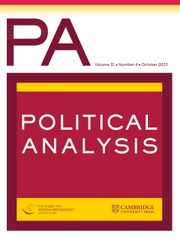Article contents
Measuring Transparency
Published online by Cambridge University Press: 04 January 2017
Abstract
Transparency is often viewed as crucial to government accountability, but its measurement remains elusive. This concept encompasses many dimensions, which have distinct effects. In this article, we focus on a specific dimension of transparency: governments' collection and dissemination of aggregate data. We construct a measure of this aspect of transparency, using an item response model that treats transparency as a latent predictor of the reporting of data to the World Bank's World Development Indicators. The resultant index covers 125 countries from 1980 to 2010. Unlike some alternatives (e.g., Freedom House), our measure—the HRV index—is based on objective criteria rather than subjective expert judgments. Unlike newspaper circulation numbers, HRV reflects the dissemination of credible content—in that it has survived the World Bank's quality control assessment. In a validation exercise, we find that our measure outperforms newspaper circulation as a predictor of Law and Order and Bureaucratic Quality as measured by the ICRG, particularly in autocracies. It performs as well as newspaper circulation in predicting corruption. These findings suggest that data dissemination is a distinct, and politically relevant, form of transparency.
- Type
- Research Article
- Information
- Copyright
- Copyright © The Author 2014. Published by Oxford University Press on behalf of the Society for Political Methodology
Footnotes
Authors' note: We would like to thank Neal Beck, Adam Bonica, Lawrence Broz, Christina Davis, Jennifer Gandhi, Michael Gilligan, Andrew Little, Jonathan Nagler, Megumi Naoi, William Skorupski, Randall Stone, Johannes Urpelainen, and participants in the 2011 MPSA Panel on New Methodologies and Data for IPE, the NYU Workshop on Bayesian Methods, the 2012 ISA Panel on Transparency, Information and Firms in a Global Economy, and the Stanford University Methods Workshop for helpful comments and suggestions. We would also like to thank the Minnesota Supercomputing Institute for access to their resources. All remaining errors are our own. Replication materials for this article are available on the Dataverse site for this article, http://dx.doi.org/10.7910/DVN/24274. We will also upload all replication files, our index, and related work to http://HRVtransparency.org. Supplementary materials for this article are available on the Political Analysis Web site.
References
- 130
- Cited by


